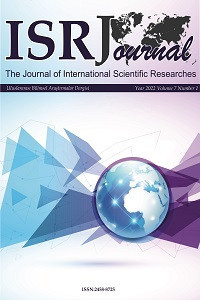Sosyal Medya Reklamlarında Fenomen Kullanımı ve Reklam İzleme Tercihi
Sosyal Medya, Fenomen, Reklam
Usage of Micro Celebrity in Social Media Advertising and Ad Tracking Preference
Social Media, Micro Celebrity, Advertising,
___
- Anderson, M. & Jıang, J. (2018). Teens, social media and technology. Erişim Tarihi, Http://www.Pewinternet.Org/2018/05/31/Teens-Social-Media-Technology-2018/. (07.09.2018)
- Sabuncuoğlu, A. & Göker, G. (2014). Sosyal Medyadaki Yeni Kanaat Önderlerinin Birer Reklam Aracı Olarak Kullanımı: Twitter Fenomenleri Üzerine Bir Araştırma. İletişim Kuram ve Araştırma Dergisi, 38, 1-24.
- Elden, M. (2009), Reklam ve Reklamcılık, İstanbul: Say Yayınları.
- Erdogan, B. Z. (1999). Celebrity Endorsement: A Literature Review. Journal of Marketing Management, 15(4), 291-314.
- Belch, G. E. & Belch, M. A. (2013). A Content Analysis Study Of The Use Of Celebrity Endorsers In Magazine Advertising. International Journal Of Advertising: The Review Of Marketing Communications, 32 (3), 369-389.
- Deneçli, C. (2015). Reklamlarda Ünlü Kullanımında Cinsiyetin Marka İmajı Üzerindeki Etkisi. Marmara Üniversitesi Öneri Dergisi , 11(44), 337-350.
- Dyck, F. V. (2015), Yeni Nesil Reklamcılık, (V. Eke, Çev.), İstanbul: The Kitap.
- Gallegos, J. A. (2017). 9 Things We Learned From The 2018 User Generated Content Report Study. (Erişim Tarihi: 09.09.2018). https://www.tintup.com/blog/9-things-learned-2018-user-generated-content-report/
- Glesne, C. (2014). Nitel Araştırmaya Giriş, ( A. Ersoy & P. Yalçınoğlu, Çev. Ed.), Ankara: Anı Yayıncılık.
- Influencer nedir? (2016), Erişim http://digitalage.com.tr/influencer-nedir/. (15.09.2018).
- Ketelaar, P. E., Janssen, L., Vergeer, M., Reijmersdal, E. A., Crutzen, R. & Riet, J. (2016). The Success Of Viral Ads: Social And Attitudinal Predictors Of Consumer Pass-On Behavior On Social Network Sites. Journal of Business Research, 69 (7), 2603-2613.
- Kim, S. S., Lee, J., Prideaux, B. (2014). Effect of celebrity endorsement on tourists’ perception of corporate image, corporate credibility and corporate loyalty. İnternational Journal of Hospitality Management, 37 (2014), 131-145.
- Khan, M. (2006). Consumer Behaviour. New Delhi: New Age International Publishers.
- Kotler, P., Kartajaya, H. & Setiawan, I. (2017). Pazarlama 4.0. (N. Özata, Çev.). İstanbul: Optimist Yayın.
- Marwick, A. & Boyd, D. (2011). To See and be Seen: Celebrity Pratice on Twitter. The International Journal of Research into New Media Technologies, 17(2) 139–158.
- McCracken, G. (1989) . Who Is the Celebrity Endorser? Cultural Foundations of the Endorsement. Journal Of Consumer Research, 16, 310-321.
- Özdestici, H. (2018). Influencer marketing 2018: şimdi biz kiminle etkileşiyoruz?. Erişimin Tarihi: 16.09.2018, https://netvent.com/influencer-marketing-2018-simdi-biz-kiminle-etkilesiyoruz/.
- Ryan, D. (2016). Dijital Pazarlama. (M. M. Kemaloğlu, Çev.). İstanbul: Türkiye İş Bankası Kültür Yayınları.
- Schroath, Kristen J. (2016). Parasocial Interaction: Celebrity Endorsements. Kent State University College: Unpublished Doctoral Thesis.
- Shaughnessy, J.O. & Shaughnessy, N.J. (2003). Persuasion in Advertising. New York: Routledge.
- Senft, T. M. (2008). Camgirls, celebrity & community in the age of social networks. (ErişimTarihi: 17.09.2018) https://books.google.com.tr/books.
- Türkiye ınfluencer marketing raporu (2018), Erişim Tarihi: 17.09.2018 https://creatorden.com/2017-turkiye-influencer-marketing-raporu/.(http://www.tuik.gov.tr/PreTablo.do?alt_id=1028). (Erişim tarihi:23.11.2017)
- https://wearesocial-net.s3.amazonaws.com/wp-content/uploads/2018/01/DIGITAL-IN-2018-002-TIME-SPENT-ON-THE-INTERNET-V1.00.png. (Erişim Tarihi: 18.05.18).
- Influencer nedir? 08.02.2016 http://digitalage.com.tr/influencer-nedir/. Erişim Tarihi: 15.09.2018
- ISSN: 2458-8725
- Yayın Aralığı: Yılda 3 Sayı
- Başlangıç: 2016
- Yayıncı: Salih YILDIZ
Marka Olarak Spor Kulüplerinin Sosyal Medya Kullanımı: Türk Spor Kulüpleri Üzerine Bir Araştırma
Erol DÖNEK, Merve ÖZKAYNAK, Mine ULUSOY
Şehir Markalaşmasında Tarihi Yapıların Rolü: Konya-Selçuklu Yapıları
Merve ÖZKAYNAK, Mine ULUSOY, Erol DÖNEK
Semantik Web’in Marka İtibarına Etkisi Üzerine Bir Araştırma
İnsan Mekân İlişkisi Ölçeğinde Kent Kimliği ve Gümüşhane Örneği
Kültürel Mirasın Ekonomik Değer ve Marka Şehir Pazar Performansına Etkisi
Kutalmış Emre CEYLAN, Abdullah ERAVCI
Türkiye’de Cittaslow (Yavaş Şehir) Hareketi ve Bir Öneri: Gümüşhane Merkez İlçesi
Aynur YÜCE, Hülya DEMİR YALEZE
Yer Markacılığı Bağlamında Engelsiz Marka Şehirlerinin Gümüşhane Örneğinde Analizi
Marka Değerinin Hesaplanmasında Farklı Bir Yaklaşım: Geliştirilmiş Hirose Yöntemi
Alper Veli ÇAM, Yusuf KALKAN, Şafak Sözmez SOYDAŞ, Seda SAĞLAMYÜREK TAŞDEMİR
Şehir Markalaşmasında Online İçeriğin Önemi: Gümüşhane Örneği
